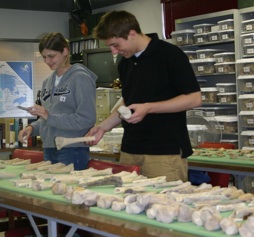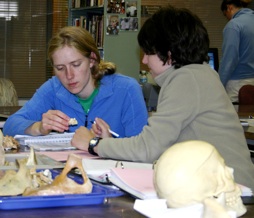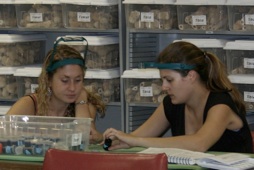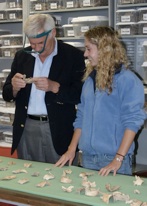A National Science Foundation Research Experiences for Undergraduates Site
Department of Anthropology, University of Notre Dame, Notre Dame, IN 46556

Tamara Semen [Ohio State University] & Tyler Shugg [University of Notre Dame]
This study systematically observed periostosis within the St Stephen’s Byzantine monastery collection. While the exact cause of periostosis can not be discerned for individual monks, determining the frequency and intensity of the periosteal reaction provides an understanding of group morbidity. Periostosis is a cellular response that causes inflammation of the bone due to a tear in the periosteum. The bone sends osteoclasts to the site of trauma, attempting to rid itself of the foreign pathogens. The accumulation of cellular fluid to the location increases tissue mass while new bone is laid down. Currently, any trauma or pathogen that gets underneath the periosteum can develop into periostosis. For Byzantine St. Stephen’s, the localized nature of the periosteal lesions suggest trauma as the etiological agent. The moderate level of periostosis does not point to a problem in the overall health of the population, but suggests a relatively healthy community who was able to cope with and survive the daily traumas that they faced performing their work in such a biologically strenuous setting.

Kendra Loebs [University of Puget Sound] & Grace Samolcyzk [University of Notre Dame]
The purpose of this study was to survey the incidence of osteoarthritis in the shoulder and elbow joints to aid in the reconstruction of activity patterns in the Byzantine St. Stephen’s collection. Six landmarks were scored for the presence of three osteoarthritic indicators. The historical literature indicates that the monks from this and other monasteries were involved in strenuous manual labor, such as gardening, gathering, and building, which utilized the upper limbs. In the St. Stephen’s collection, little difference is seen in the prevalence of osteoarthritis between sides, except for the humeral head. Analysis of the types and prevalence of osteoarthritis in Byzantine St. Stephen’s and comparative groups shows that some groups are highly similar while others are significantly different in terms of the percentage of individuals affected by osteoarthritis. This may indicate that similar activities were performed by the members of these groups.

Dental Calculus and Phytolith Analysis
Elizabeth Browning [Ohio State University] & Katie Keegan [University of Notre Dame]
Calculus samples were analyzed, showing a high degree of light calculus on the buccal and lingual surfaces of the teeth. This may have resulted from protein consumption or patterns of oral hygiene. A methodology was developed to prepare the phytolith samples from the calculus for analysis using a light microscope. The first part of the project addressed the dental calculus component of the research, the latter segment outlined methods for phytolith analysis.
\


Previous NSF-REU Summers
A summary of previous research projects can be found:





Guest Scientist
Prof. Donald Ortner of the Smithsonian Institution’s Museum of Natural History will be the guest scientist for the 2007 Program. He will work with each group to fine tune their research design as well as provide instruction on various aspects of paleopathology.
-
✦Prof. Ortner’s Smithsonian Webpage
-
✦Natural History Museum at the Smithsonian







